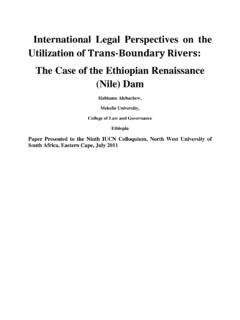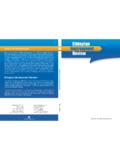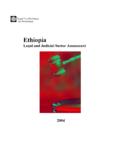Transcription of Federal Democratic Republic of Ethiopia - OECD.org
1 Federal Democratic Republic of Ethiopia Ministry of Water and Energy Scaling - Up Renewable Energy Program Ethiopia Investment Plan (Draft Final) January 2012 ii TABLE OF CONTENTS Table of Contents .. ii List of Figures and Tables .. iii List of Abbreviations .. iv Proposal Summary .. v I. Country Context .. 1 The Energy Sector in Ethiopia .. 1 Institutional Structure and Capacity .. 7 II. Renewable Energy Sector Context .. 9 Analysis of RE 9 Barrier analysis .. 11 Government Plans and Strategy for the Sector .. 13 III. Program Description .. 20 Selection of Programs for SREP Funding .. 20 Evaluation of candidate projects .. 26 Environmental Impact Assessment Governance System .. 28 IV. Financing Plan and Instruments .. 30 Sources of Financing .. 30 V. Additional Development Activities .. 32 VI. Implementation Potential with Risk 35 VII. Monitoring and Evaluation .. 37 VIII.
2 Annexes .. 41 Annex 1: Investment 42 Annex 2: Ethiopia Absorptive Capacity .. 64 Annex 3: Stakeholders 66 Annex 4: SREP Co-Benefits .. 73 Annex 5: Investment Plan Review .. 76 Annex 6: MDB Request for Payment of Implementation Service Costs and Request for Project Preparation Grant .. 77 iii LIST OF FIGURES AND TABLES Figure 1: Power Demand and Supply .. 3 Figure 2: Hydro Projects Unit Generation Cost .. 4 Figure 3: Output Overview .. 5 Figure 4: Unit Generation Cost by Source Type .. 6 Figure 5: Government Structure for the Energy Sector .. 8 Figure 6: SREP Institutional 39 Table 1: Financing Matrix .. vii Table 2: Channeling of SREP Resources .. viii Table 3: 2010/2011 GC Energy Consumption by Tariff Category .. 2 Table 4: Current and Future Generation Composition of the Power System .. 5 Table 5: Electricity Tariff since 2006 .. 7 Table 6: Barriers for Renewable Energy 11 Table 7: Evaluation Matrix.
3 27 Table 8: Financing Matrix .. 30 Table 9: Indicative Expected Timeline for MDB Approval of Project Preparation Grants and Investment Projects .. 31 Table 10: Recent and Ongoing Projects/Initiatives in RE and energy access .. 32 Table 11: Program Level .. 36 Table 12: SREP Ethiopia Results Framework .. 37 Table 13: M&E System Management .. 40 iv LIST OF ABBREVIATIONS AFD French Development Agency SCS Self-Contained System BADEA Arab Bank for Economic Development of Africa SNNPR Southern Nations Nationalities and Peoples Region COOPI International Cooperation (Italy) SNV Netherlands Development Organization CRGE Climate Resilient Green Economy SREP Scaling-up of Renewable Energy Program CSA Central Statistics Agency USD United States Dollar EC European Commission EIB European Investment Bank EEA Ethiopian Electricity Agency EEPCO Ethiopian Electric Power Corporation EPA Environmental Protection Authority GEF Global Environmental Facility GHG Green House Gas GoE Government of Ethiopia GSE Geological Survey of Ethiopia GTP Growth and Transformation Plan GWh Giga Watt hour HoA-REC/N Horn of Africa Regional Environment Centre and Network HV High Voltage INBAR International Network for Bamboo and Rattan ICS Interconnected System IP Investment Plan LED Light Emitting Diode LV Low Voltage MoFED Ministry of Finance and Economic Development MoM Ministry of Mines MoWE Ministry of Water and Energy MW
4 Mega Watt NBPE National Biogas Program of Ethiopia NGO None Governmental Organizations OPEC FID Organization of Petroleum Exporting Countries Fund for International Development REF Rural Electrification Fund RET Renewable Energy Technologies REES Rural Electrification Executive Secretariat v PROPOSAL SUMMARY Objectives 1. Driven by accelerating socio - economic growth and development, Ethiopia is experiencing increased energy consumption and unmet demand for the last 7 years. In this regard, the major objective of the energy sector during the existing 5 year Growth and Transformation Plan period (GTP) and beyond is to meet the demand for energy in the country by providing sufficient and reliable power supply that meets international standards at all times. This objective will be achieved by accelerating and completing the construction of hydroelectric power and other renewable energy generation projects, expanding and strengthening the existing transmission and distribution lines to provide improved access to rural villages all over the country.
5 An additional objective is to export power to the neighboring countries. Modernizing the distribution system will also be considered, so as to reduce power losses to international benchmark levels. 2. Development of alternative energy from renewable sources such as wind, geothermal, solar, biomass as well as energy efficiency measures will be a key part of Ethiopia s energy mix and integrated with the country s new Climate Resilient Green Economy (CRGE) Strategy, which has the ambitious objective of a transforming Ethiopia into climate resilient green economy by 2025. The GTP and the CRGE as well as other national development plans are explicitly focused on addressing issues of energy access, quality of supply and productive energy use in the context of new energy policies and planning. 3. Potential SREP investments have thus been prioritized vis- -vis their contribution to assisting the Government of Ethiopia (GoE) in meeting the overall demand for energy and improve access to energy at international standards as per the GTP, while adhering to the low-carbon mission statement of the CRGE and addressing the GoE s broader structural concerns regarding energy access and productive energy use, particularly for rural communities focusing on women and girls.
6 Expected Outcomes 4. SREP is embedded in Ethiopia s GTP, which sets the major outcomes for the energy sector in the short-term, as well as the CRGE, which provides a road map for the country s long-term low-carbon growth path. The GTP aims to increase the power generation capacity of the country from the present level of 2000 MW to 10,000 MW by the end of 2015. The aim is to address both domestic demand while exporting surplus power to neighboring countries and beyond. The need to expand the transmission and distribution system is also emphasized in order to deliver the energy generated to the consumer in an efficient and reliable manner. The GTP further envisages increasing the customer base of vi the power utility from the current level of 2 million to 4 million and the universal electricity access rate from 45% to 75%. 5. It further aims at increasing the dissemination of renewable energy technologies and increasing access to modern energy sources in order to reduce the deforestation rate and mitigate carbon emissions.
7 At the end of the GTP period at least 80 % of households where majority of women and girls will be beneficiaries of modern energy services from dissemination of efficient cook stoves and other RE sources since in most cases they are in charge of collecting firewood and other types of fuel. This has an effect on their lives namely in terms of health, less access to school for girls, risk of violence and abduction. Furthermore, in many cases, the time used in the collection of firewood could be used for economic activities (for women), and better attendance to school (for girls). 6. Successful implementation of SREP will pave the way for improving the energy mix of the national power system by incorporating geothermal and wind power in a sustainable way, thereby increasing the system s reliability and resilience towards climate change. It will also accelerate the electrification of the country by making more energy available in the system.
8 With the radically scaled-up dissemination of improved cook stoves though training and capacity building of SME s that will facilitate the development of private sector participation and will bring transformation and sustainable exploitation of the country s biomass resources, SREP will help alleviate the social, economic and environmental problems faced largely by the rural population, especially women and girls by allowing them to spend time in productive activities and improving their health. At the same time a significant contribution to Ethiopia s goals of achieving the reductions in green-house gas emissions as set in the CRGE strategy document. Program criteria, Priorities, Financing Matrix and Channeling of Funds 7. The SREP Investment Plan (IP) has analyzed various options for the scaling-up of renewable energy utilization based on all the known renewable energy sources of the country (including hydropower below 10 MW) within the planning horizon of 2011 - 2015.
9 The total budget requirement for the renewable energy investment outside of the large hydropower and the transmission and distribution network extension, requiring intervention from SREP and other leveraged sources of finance, is USD 532 million. Investments were ranked and prioritized according to the following seven criteria: i. Strategic relevance to the country s development; ii. Gender Equality Promotion; iii. Positive impact; iv. Potential to scale-up; v. Cost effectiveness; vii vi. Potential for new direct beneficiaries; vii. Implementation readiness. 8. Based on this exercise and according to the criteria mentioned, the following components have been prioritized with their accompanying budget requirements as presented in Table 1 below. TABLE 1: FINANCING MATRIX SREP # Project Total Cost GoE SREP MDBs Others Initial Allocation 1 Aluto Langano Geothermal Field Development - Component I: Aluto Langano Geothermal Power Generation Project Phase I: Appraisal and Production Drilling ** * Phase II: Power Plant and Transmission Line Construction - + ** - Component II.
10 Design of a Long-Term Strategy for the Geothermal Sector - - 2 Assela Wind Farm Project ++ Project Preparation Grant (feasibility study) 2 - - Construction 248 3 Clean Energy SMEs Capacity Building and Investment Facility - +++ Project Preparation Grant (Scoping Study) - - - Advisory Services and Capacity Building - - - Financing Facility - SUB-TOTAL 200 Reserve 4 Tendaho Geothermal Field Development 5 Sor SHEPP Expansion Project - SUB-TOTAL TOTAL * It includes a USD 10 million from Government of Japan. The USD million gap is expected to be closed by other donors. In case this amount is not secured, the GoE will come up with the amount. ** USD 10 million co-financing from the WB. ** Following preliminary discussions between the GoE and the GoJ, the gap is expected to be closed by the GoJ (USD 50 million) + USD 50 million will be used to finance the construction of the Power Plant and is pending country s allocation under the next cycle of ADF and/or IDA.
















